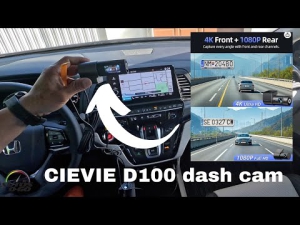Want a Dash Cam? Get the Thinkware F70
Dash cams are an excellent device to have in your car, serving as cold-hard proof of the craziest accidents. And while some dash cams can serve as driving assistants, they can also be rather expensive. The Thinkware F70 is everything a dash cam should be without being too complex or expensive. How do I know? I just took one on a 1,000-mile road trip.
The facts and features of the Thinkware F70 Dash Cam
The Thinkware F70 can be bought for $90 on their website (though it was on sale for $50 when I purchased it). That’s certainly a hefty chunk of change, but you get what you pay for. For starters, it’s small enough to tuck behind your rearview mirror, out of the driver’s way. But this cylindrical camera is packed with some great features.
The dash cam records a continuous stream of one-minute clips. That way you don’t end up with one large file, you end up with 100 small ones. But the Thinkware F70 features an Impact Detection mode. If you get in an accident, the camera will beep, indicating that it recognizes the accident. Rather than having to sift through 100s of clips, the F70 automatically records 10 seconds before and 10 seconds after the beep and stores it in a separate folder.
Speaking of folders, let’s talk about the tech: the F70 comes with an 8GB micro SD card, which was enough to record my nonstop 13-hour road trip from Florida to Maryland. However, the file size isn’t small, but rather the dash cam will only save up to one hour of clips (or 60 clips). That means the F70 can record continuous footage without ever running out of space since it automatically deletes old clips.
The files are bigger because the video quality is higher, recording at a constant 1080p. And you have the option of recording sound, so which can be turned off by holding the record button for a couple of seconds. But that’s not even scratching the surface of what your Thinkware F70 can do.
If you wire the camera to constantly be on (which might drain the life of your battery faster), the F70 has motion sensor technology. That means that, in a parking lot, it only records when it detects motion, which can stop thieves from messing with your car. Personally, I have mine set to turn off with the car, as if someone is going to steal my automobile, there’s no way I can get the camera back.
A couple of quirks and complaints

Don’t get me wrong, I love this little thing, but I do have a few complaints. One minor issue is the green light indicating whether the camera is on and recording is incredibly dim. At night you can see it, but during the day it’s hard to tell. The best way to make sure the dash cam is on is by holding the record button to make sure it can enable/disable sound recording. That’s a hassle and requires you to take a hand off the wheel, a problem that’d be solved with a better bulb.
Then there’s the impact detection. It’s a brilliant feature no doubt, but it’s also a bit sensitive. Going over bumps and train tracks a bit too can set it off. Another minor issue, but one you should be aware of. I was incredibly confused the first time my camera beeped while driving, worried that it’d shut off. So if you hear the beep and didn’t get into a crash, it’s just the impact detection system thinking you did.
How to install the dash cam (and how I installed it)

You have a handful of options when installing the dash cam in your car. You can purchase it with a 12v cigarette lighter to plug into the car, as well as an OBD2 connector. Both of these are fine choices if you don’t mind looking at cables or use the outlets for much. I’d recommend hard-wiring the cable if you’re looking for a clean installation.
You can take this into a dealer and they’ll hardwire it for you, feeding the wire through your trim and around the airbags, but the process is fairly simple: First, you should disconnect your battery if you have any side cushion airbags. That way you can feed the wire through and tuck it behind the A-pillar.
After you’ve done that, fiddle with your fuse box and connect each of the cables to certain types of power. There’s constant power (the red cable) and switched power (the yellow cable). Constant means it’s always powered, such as the anti-theft system, whereas switched if for when the car is on, such as the radio.
There are adapters you buy and cables you have to crimp so that the fuse is secure and the wire just goes through it. I, however, am a simple man. And rather than doing any complex cable work, I simply wrapped the wire around one end of the fuse and shoved it in there. It’s janky, and it’s not recommended, but it works just fine. Saves you a lot of money, and keeps the wiring clean.
How you install it is up to you, but if you want that extra peace of mind, having a dash cam in your car is worth the investment. And of all the options out there, the F70 has proven to be road-trip-worthy.
RELATED: Are Dash Cams Illegal in Your State? Here’s What You Need to Know
The post Want a Dash Cam? Get the Thinkware F70 appeared first on MotorBiscuit.







